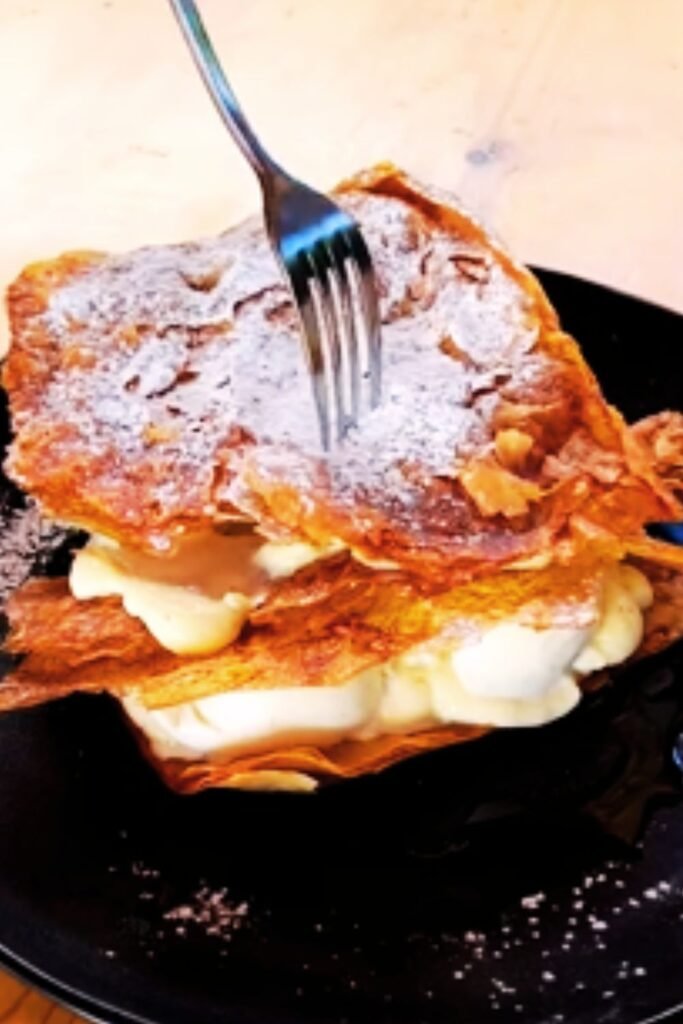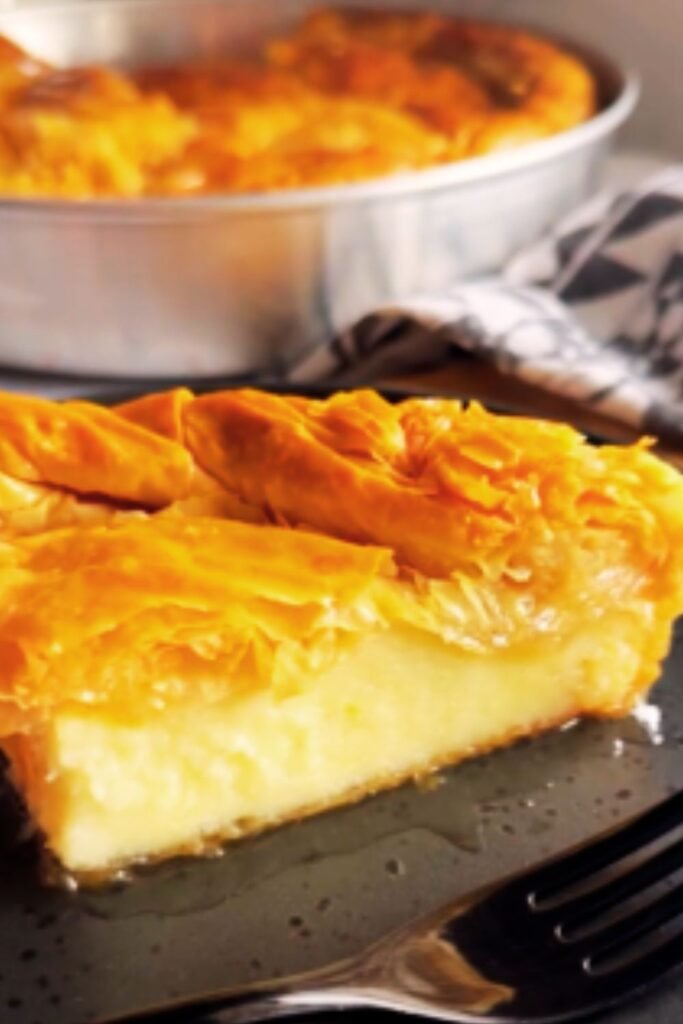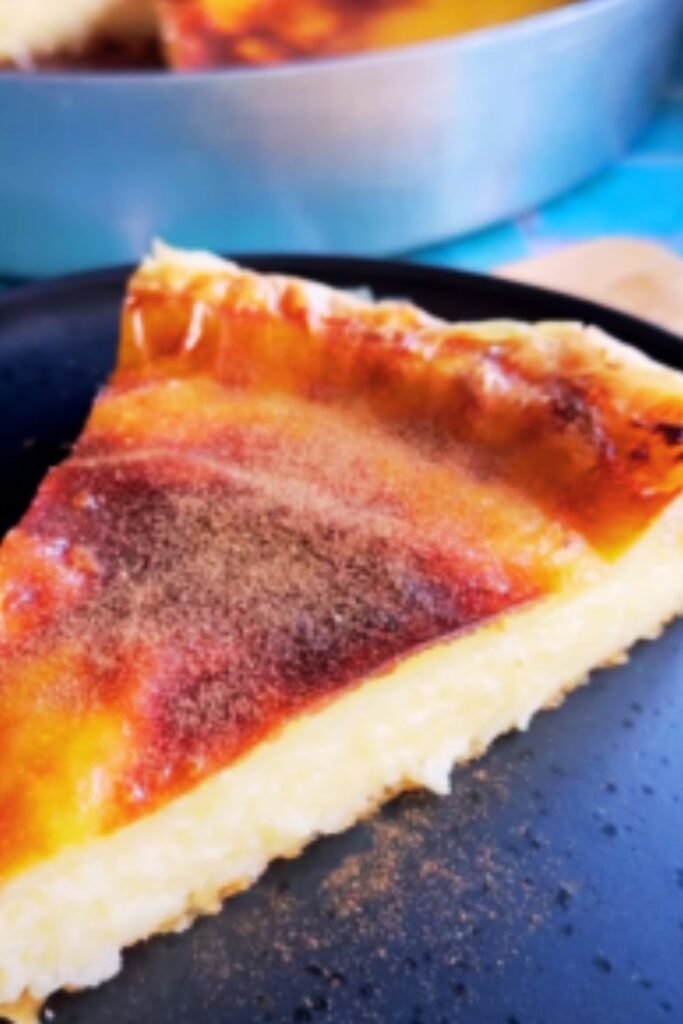There’s something magical about the way traditional Greek desserts combine simplicity with incredible flavor. As someone who has spent years exploring Mediterranean cuisine, I’ve developed a special appreciation for galatopita, a humble yet luxurious milk custard pie that has been gracing Greek family tables for generations.
When I first tasted authentic galatopita in a small family-run taverna on the outskirts of Thessaloniki, I was instantly transported to dessert heaven. The silky smooth custard, delicately perfumed with vanilla and citrus, all encased in a tender phyllo crust – it was an experience that stayed with me long after the last bite disappeared.
Today, I’m excited to share everything I’ve learned about this beloved Greek dessert, from its cultural significance to step-by-step instructions for creating your own perfect galatopita at home. Whether you’re a seasoned baker or a curious food enthusiast looking to expand your culinary horizons, this traditional treat is approachable, impressive, and absolutely delicious.
What is Galatopita?
Galatopita (γαλατόπιτα) is a traditional Greek dessert whose name literally translates to “milk pie.” The word comes from the Greek “gala” (γάλα) meaning milk and “pita” (πίτα) meaning pie.
While regional variations exist throughout Greece, the essence of galatopita remains consistent: a creamy, custard-like filling made primarily from milk, eggs, and semolina flour, often flavored with vanilla and citrus zest. This luscious mixture is then baked until set, resulting in a dessert that balances delicate sweetness with rich texture.
The defining characteristics of galatopita include:
- Texture: Silky smooth interior with a slightly firmer top
- Flavor profile: Creamy, milky taste with subtle notes of vanilla and often citrus
- Appearance: Golden brown surface, sometimes with a caramelized top
- Serving style: Typically dusted with cinnamon and served at room temperature or chilled
The Cultural Significance of Galatopita
In Greek culture, food and family are deeply intertwined, and desserts like galatopita play an important role in celebrations and gatherings. I’ve learned that this humble milk pie has been a staple in Greek households for centuries, with recipes passed down through generations.
Traditionally, galatopita was a practical dessert that rural families could make with readily available ingredients. Milk from family-owned goats or sheep, eggs from the coop, and flour from the local mill were transformed into something special that could feed many mouths at once.
In many Greek regions, galatopita makes regular appearances at:
- Easter celebrations (especially during the fasting period when modified versions might be prepared)
- Name day celebrations (a tradition where Greeks celebrate the feast day of the saint they’re named after)
- Sunday family gatherings
- Village festivals (πανηγύρια/panigyria)
The dessert also represents Greek ingenuity in creating something extraordinary from simple ingredients – a characteristic that defines much of the country’s beloved cuisine.
Regional Variations
As with many traditional recipes, galatopita takes on different forms depending on the region of Greece. During my culinary explorations, I’ve discovered several distinctive variations:
Northern Greek Style
In northern regions like Macedonia and Thessaly, galatopita often includes a phyllo dough base and top, creating a more defined “pie” structure. The custard is typically flavored with vanilla and lemon zest.
Peloponnese Version
In the Peloponnese peninsula, the dessert sometimes features a thicker, more pudding-like consistency with the addition of more semolina. Orange zest is often the preferred citrus flavoring.
Island Variations
On islands like Crete and Cyprus, you might find galatopita infused with local honey and sometimes mastic (a resin from the mastic tree with a unique pine-like flavor), giving it a distinctive aromatic quality.
Modern Interpretations
Contemporary Greek pastry chefs are now experimenting with galatopita, creating versions with chocolate, berries, or even savory ingredients like feta cheese for an appetizer version.

Essential Ingredients
What makes galatopita special is not an extensive list of exotic ingredients, but rather the careful treatment of a few simple components. Here’s what you’ll need to create authentic galatopita:
Primary Ingredients
| Ingredient | Purpose | Notes |
|---|---|---|
| Milk | Forms the base of the custard | Whole milk is traditional, but 2% can work. Some recipes use a combination of milk and cream for added richness. |
| Eggs | Provides structure and richness | Whole eggs create a balanced texture, while some recipes use additional yolks for extra richness. |
| Semolina flour | Thickens the custard | Fine semolina (not coarse) yields the best texture. This is essential for authentic galatopita. |
| Sugar | Sweetens the dessert | White granulated sugar is traditional, though some family recipes use honey for part of the sweetness. |
| Vanilla | Adds aromatic flavor | Either vanilla extract or a whole vanilla bean for more intense flavor. |
| Citrus zest | Brightens the flavor profile | Lemon or orange zest (or both) adds dimension to the custard. |
| Butter | Enriches the custard and helps with browning | Unsalted butter is preferred. Some recipes include melted butter in the custard, while others use it primarily for greasing the pan. |
| Phyllo dough | Creates the crust (in some versions) | Not all galatopita recipes include phyllo, but many traditional versions do. |
| Cinnamon | For dusting | Applied after baking as a finishing touch. |
Special Equipment
While galatopita doesn’t require fancy tools, a few key items will help ensure success:
- Heavy-bottomed saucepan: Prevents the milk mixture from scorching
- Whisk: For creating a smooth custard without lumps
- Baking dish: Traditional recipes use round baking dishes, though square or rectangular ones work too
- Fine grater: For citrus zest
- Food thermometer: Optional but helpful for knowing when the custard reaches the proper temperature
Step-by-Step Recipe
After years of practice and learning from Greek home cooks, I’ve developed this reliable recipe for classic galatopita. Follow these steps carefully, and you’ll be rewarded with a dessert that tastes authentically Greek.
Ingredients:
- 4 cups (1 liter) whole milk
- 1 cup (200g) granulated sugar
- 1/2 cup (80g) fine semolina flour
- 4 large eggs
- 2 tablespoons butter, plus more for greasing
- 1 teaspoon vanilla extract
- Zest of 1 lemon
- Zest of 1/2 orange (optional)
- 1/4 teaspoon salt
- Ground cinnamon for dusting
For phyllo-based version (optional):
- 6-8 sheets phyllo dough
- 1/4 cup (60g) melted butter for brushing
Instructions:
- Prepare your baking dish
- Preheat your oven to 350°F (175°C).
- Thoroughly butter a 9-inch (23cm) round baking dish or pie plate.
- If using phyllo dough, lay sheets in the dish, brushing each with melted butter, allowing edges to hang over the sides.
- Create the custard base
- In a large heavy-bottomed saucepan, combine milk and sugar.
- Heat over medium heat, stirring occasionally until the sugar dissolves and the milk is hot but not boiling.
- Reduce heat to low once bubbles begin to form around the edges.
- Add the semolina
- Gradually whisk in the semolina flour, ensuring no lumps form.
- Continue stirring constantly for about 5-7 minutes until the mixture begins to thicken.
- Remove from heat when the mixture reaches a pudding-like consistency that coats the back of a spoon.
- Temper the eggs
- In a separate bowl, lightly beat the eggs.
- Gradually add about 1 cup of the hot milk mixture to the eggs, whisking constantly.
- This step “tempers” the eggs, preventing them from scrambling when added to the hot mixture.
- Combine and flavor
- Pour the tempered egg mixture back into the saucepan with the remaining milk mixture.
- Return to low heat and cook for 2-3 minutes, stirring constantly.
- Remove from heat and stir in the butter, vanilla extract, citrus zest, and salt.
- Bake the galatopita
- Pour the custard mixture into your prepared baking dish.
- If using phyllo, fold the overhanging edges over the top of the custard, brushing with more melted butter.
- For non-phyllo version, simply pour the mixture directly into the buttered dish.
- Bake for 40-45 minutes, or until the top is golden brown and the center is mostly set (it should jiggle only slightly when gently shaken).
- Cool and serve
- Allow the galatopita to cool completely in the dish (at least 2 hours).
- Dust generously with ground cinnamon before serving.
- Cut into wedges and serve at room temperature or chilled.

Troubleshooting Common Issues
Even experienced bakers can encounter challenges when making galatopita. Here are solutions to the most common problems I’ve encountered:
Custard is lumpy
- Cause: Semolina was added too quickly or milk was too hot when eggs were added
- Solution: Strain the mixture through a fine-mesh sieve before baking, and next time, add semolina more gradually while whisking constantly
Custard is too runny after baking
- Cause: Insufficient cooking time or oven temperature too low
- Solution: Bake for additional 5-10 minute increments until set, and verify your oven temperature with an oven thermometer
Custard is rubbery or too firm
- Cause: Overcooked or too much semolina used
- Solution: Reduce baking time in future batches and measure semolina precisely
Top is too dark but center isn’t set
- Cause: Oven temperature too high
- Solution: Lower oven temperature by 25°F and cover loosely with foil if top is browning too quickly
Phyllo crust is soggy
- Cause: Insufficient butter between layers or custard too wet
- Solution: Ensure each phyllo sheet is adequately brushed with butter and consider pre-baking the phyllo crust for 5-10 minutes before adding the custard
Serving Suggestions
In my experience, galatopita shines as both an everyday treat and a special occasion dessert. Here are my favorite ways to serve this Greek classic:
- Traditional style: Dust with cinnamon and serve slightly chilled or at room temperature
- Summer refresher: Pair with fresh seasonal berries and a small dollop of Greek yogurt
- Breakfast treat: Serve alongside a strong Greek coffee for an authentic morning experience
- Dinner party finale: Drizzle with a touch of honey and sprinkle with crushed pistachios for an elegant presentation
- Tea time complement: Offer small squares with a cup of mountain tea or chamomile
For a more substantial dessert spread, galatopita pairs beautifully with other traditional Greek sweets like:
- Baklava (for those who want something with more texture)
- Fresh fruit (especially figs or peaches when in season)
- A small scoop of kaimaki ice cream (mastic-flavored Greek ice cream)

Nutritional Information
For those watching their nutritional intake, here’s a breakdown of what you can expect from a standard slice of galatopita (approximately 1/8 of the recipe):
| Nutrient | Amount per Serving | % Daily Value* |
|---|---|---|
| Calories | 285 | 14% |
| Total Fat | 12g | 15% |
| Saturated Fat | 7g | 35% |
| Cholesterol | 115mg | 38% |
| Sodium | 140mg | 6% |
| Total Carbohydrate | 38g | 14% |
| Dietary Fiber | 0.5g | 2% |
| Sugars | 26g | – |
| Protein | 8g | 16% |
| Calcium | 180mg | 14% |
| Iron | 0.5mg | 3% |
| Vitamin A | 390IU | 8% |
*Percent Daily Values are based on a 2,000 calorie diet
While galatopita is undeniably an indulgence, it offers more nutritional value than many desserts due to its high milk content, providing calcium and protein. For a lighter version, you can substitute 2% milk for whole milk and reduce the sugar slightly.
Making Ahead and Storage
One of the wonderful things about galatopita is that it actually improves with a bit of time, making it perfect for preparing ahead of gatherings. Here’s what I’ve learned about making and storing this dessert:
Make-Ahead Options:
- The custard mixture can be prepared up to 24 hours in advance and refrigerated before baking
- Fully baked galatopita can be made 1-2 days before serving and stored in the refrigerator
- For best flavor, I recommend making it at least 4 hours before serving to allow the flavors to develop fully
Storage Guidelines:
- Cover leftover galatopita with plastic wrap or transfer to an airtight container
- Refrigerate for up to 5 days
- Do not freeze – the texture becomes grainy when thawed
Reheating (if desired):
- While traditionally served cold or at room temperature, some people enjoy warm galatopita
- To reheat individual slices, microwave for 20-30 seconds or warm in a 300°F (150°C) oven for 10 minutes
- Be careful not to overheat, as this can cause the custard to separate
Health Benefits and Dietary Considerations
While galatopita is primarily a dessert meant to be enjoyed in moderation, it does offer some nutritional benefits worth noting:
Potential Benefits:
- Calcium: The high milk content provides significant calcium for bone health
- Protein: Eggs and milk contribute protein essential for tissue repair and immune function
- Energy: The carbohydrates from sugar and semolina provide quick energy
Dietary Considerations:
- Gluten: Traditional galatopita contains gluten from the semolina and phyllo (if used)
- Vegetarian: The standard recipe is suitable for vegetarians
- Lactose: Contains significant amounts of dairy, making it unsuitable for those with lactose intolerance
- Eggs: Contains eggs, which are a common allergen
Dietary Adaptations:
Through experimentation, I’ve found these modifications can make galatopita accessible to those with dietary restrictions:
- Gluten-free: Replace semolina with cornstarch (use half the amount) and skip the phyllo crust
- Lactose-free: Use lactose-free milk products (results will be very similar to the original)
- Lower-sugar: Reduce sugar by up to 1/3 and add a touch of honey for sweetness
- Dairy-free: While not traditional, coconut milk can be substituted for cow’s milk (though this significantly alters the flavor profile)
Cultural Connections
My fascination with galatopita deepened when I learned about its place in Greek culture and history. This dessert reflects the Greek approach to food – simple, unfussy, and making the most of available ingredients.
In ancient Greece, milk-based desserts were indeed common, though they differed from today’s galatopita. The ancient Greeks valued milk as a nutritious food and often combined it with honey (their primary sweetener) to create early custard-like desserts.
The modern version of galatopita likely evolved during the Byzantine period when techniques for creating sweet pastries became more refined. The Ottoman influence on Greek cuisine further developed the concept of milk-based desserts, with similar preparations seen across former Ottoman territories.
Today, galatopita represents the beautiful simplicity of Greek home cooking – transforming basic ingredients into something special through careful technique and a deep understanding of flavor.
For Greeks living abroad, desserts like galatopita often serve as a tangible connection to their heritage, recreated in diaspora kitchens as a way to keep cultural traditions alive and introduce the next generation to their culinary roots.
Frequently Asked Questions
After years of making and teaching others how to make galatopita, these are the questions I’m most commonly asked:
Can I use regular flour instead of semolina? While you can substitute all-purpose flour, the texture won’t be authentic. Semolina gives galatopita its characteristic consistency. If you must substitute, use half the amount of all-purpose flour.
Why did my custard crack on top? Cracking usually occurs when the oven temperature is too high or the custard bakes for too long. Try reducing your oven temperature by 25°F and checking for doneness earlier.
Is there a dairy-free version of galatopita? Traditional galatopita relies heavily on dairy for its flavor and texture. While you can experiment with plant-based milks, the result will be quite different. Coconut milk provides the closest texture but changes the flavor significantly.
Can I add other flavorings to the custard? Absolutely! While traditional galatopita uses vanilla and citrus, you can experiment with cinnamon, mastika (mastic), mahlab (a Middle Eastern spice made from cherry pits), or even a touch of rosewater.
Why does my galatopita weep or release liquid after cutting? This happens when the custard is slightly undercooked. Next time, bake it a few minutes longer. For the current batch, simply drain any excess liquid before serving.
How can I tell when galatopita is fully baked? The top should be golden brown, and when you gently shake the pan, the center should jiggle only slightly. A knife inserted about 1 inch from the edge should come out clean.
Can I make individual servings instead of one large pie? Yes! Pour the mixture into buttered ramekins and reduce the baking time to about 25-30 minutes. This makes for an elegant presentation at dinner parties.
Final Thoughts
Galatopita holds a special place in my heart not just for its delicious flavor and comforting texture, but for what it represents – the beautiful simplicity of Greek cuisine and the warmth of Mediterranean hospitality. Every time I prepare this dessert, I’m reminded of sun-drenched tavernas, family gatherings, and the timeless appeal of recipes that have been perfected over generations.
What makes galatopita truly special is how it transforms humble ingredients into something extraordinary. With just milk, eggs, and semolina, plus a few aromatic additions, you can create a dessert that speaks to the soul of Greek cooking – unpretentious, satisfying, and deeply flavorful.
Whether you’re exploring Greek cuisine for the first time or looking to reconnect with your heritage, I hope this deep dive into galatopita inspires you to bring a taste of Greece into your kitchen. The process of making it is almost as rewarding as the first creamy, cinnamon-dusted bite.
Share your galatopita with loved ones, perhaps alongside a cup of Greek coffee, and you’ll be participating in a tradition that has brought joy to countless families across generations. After all, in Greece, food is never just about nourishment – it’s about connection, celebration, and the simple pleasures that make life sweet.


